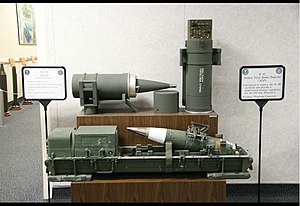W82
| W82 | |
|---|---|
Lawrence Livermore Laboratory | |
| Specifications | |
| Mass | 43 kg (95 lb) |
| Length | 860 mm (34 in) |
| Blast yield | 2 kt (8.4 TJ) |

The W82 (also known as the XM785 shell) was a low-yield
Originally envisioned as a dual-purpose weapon, with interchangeable components to allow the shell to function as either a standard fission explosive or an
Design
The shell used a body made from titanium with a copper rotating band. A special process was developed to bond the rotating band to the titanium body of the shell which prevented shell-band separation during firing.[3]
References
- ^ a b "W82 / XM-785". GlobalSecurity.org. 30 September 2018. Archived from the original on 25 January 2022. Retrieved 13 February 2021.
- OL 8050319M. Archived from the original on 15 February 2023. Retrieved 8 July 2021 – via Google Books.
- ^ Improved Bonding of Copper Rotating Bands to Titanium Artillery Shells (Poster). Watertown Arsenal, US Army. Archived from the original on 2022-06-30 – via National Archives at Boston, Box 12, Folder: Prints & Negatives, 1980-1984.
Further reading
- Hansen, Chuck, "Swords of Armageddon: U.S. Nuclear Weapons Development since 1945" (CD-ROM & download available). PDF-2.67 Mb. 2,600 pages, Sunnyvale, California, Chucklea Publications, 1995, 2007. ISBN 978-0-9791915-0-3(2nd Ed.)
